In this Post
From the
Editor: PostScript – From Famine to Feast
F.I.D.O.: From the Other Side of the World to Qimmiq Territory
Oh, those dog commands!
Dogs – One of the many reasons I loved them
Wally Herbert’s dogs – the Norwegian connection
Nansen Sledge Production
Langsomt på Svalbard (Slowly on Svalbard) Deferred for One Year
Book Review: QIMMEQ – The Greenland Sled Dog
Siu-Ling Han Memorial Scholarship
The Trip of a Lifetime
F.I.D.O.: From the Other Side of the World to Qimmiq Territory
Oh, those dog commands!
Dogs – One of the many reasons I loved them
Wally Herbert’s dogs – the Norwegian connection
Nansen Sledge Production
Langsomt på Svalbard (Slowly on Svalbard) Deferred for One Year
Book Review: QIMMEQ – The Greenland Sled Dog
Siu-Ling Han Memorial Scholarship
The Trip of a Lifetime
Navigating This Site
Index of articles by subject
Index of Journal editions by
volume number
Index of PostScript editions by publication number
Search The Fan Hitch
Articles to download and print
Ordering Ken MacRury's Thesis
Our comprehensive list of resources
Defining the Inuit Dog
Talk to The Fan Hitch
Shop & Support Center
The Fan Hitch home page
Index of articles by subject
Index of Journal editions by
volume number
Index of PostScript editions by publication number
Search The Fan Hitch
Articles to download and print
Ordering Ken MacRury's Thesis
Our comprehensive list of resources
Defining the Inuit Dog
Talk to The Fan Hitch
Shop & Support Center
The Fan Hitch home page
Editor's/Publisher's
Statement
Editor: Sue Hamilton
Webmaster: Mark Hamilton
The Fan Hitch Website and
Publications of the Inuit Sled Dog– the
quarterly Journal (retired
in 2018) and PostScript – are dedicated to the aboriginal
landrace traditional Inuit Sled Dog as well as
related Inuit culture and traditions.
PostScript is
published intermittently as
material becomes available. Online access is
free at: https://thefanhitch.org.
PostScript welcomes your
letters, stories, comments and suggestions.
The editorial staff reserves the right to
edit submissions used for publication.
Contents of The Fan Hitch Website and its publications are protected by international copyright laws. No photo, drawing or text may be reproduced in any form without written consent. Webmasters please note: written consent is necessary before linking this site to yours! Please forward requests to Sue Hamilton, 55 Town Line Rd., Harwinton, Connecticut 06791, USA or mail@thefanhitch.org
Contents of The Fan Hitch Website and its publications are protected by international copyright laws. No photo, drawing or text may be reproduced in any form without written consent. Webmasters please note: written consent is necessary before linking this site to yours! Please forward requests to Sue Hamilton, 55 Town Line Rd., Harwinton, Connecticut 06791, USA or mail@thefanhitch.org
Nansen Sledge Production
by John Wright
This
article contains a number of images showing sledges
in various stages of production. Your best viewing
experience will be from the .pdf file
available here.
Your .pdf viewer should have a function that allows
you to scale these images for more detailed viewing.
Ed.
Having written an article for The Fan Hitch PostScript #5 on the restoration of Ken Hedges ’British Trans Arctic Expedition (BTAE) Nansen sledge, Sue has persuaded me to write something about the production of Nansens. The first point to note is that there is no definitive design for a Nansen sledge, but what they have in common is that they are wooden sledges based on the pattern used by Fridtjof Nansen in the 1890s. They are built using curved runners that are joined together with bridges which generally support the load carrying deck made of a series of longitudinals. A cow catcher is fitted to the front and, for a dog sledge, handlebars and a brake are fitted to the rear. For use with a skidoo, the sledge may be made double ended with a second cow catcher.
The wood is usually ash and the sledge is assembled with a combination of hide and cord lashings to ensure flexibility. Nansen pattern sledges may be made in a variety sizes and weights to suit the method of towing: heavier for skidoos, a bit lighter for dogs and much lighter for man hauling.
A glance through literature of the Heroic Age of Antarctic exploration will show that most expeditions used sledges that could be described as Nansens. A sledge used on Shackleton’s Nimrod Expedition 1907 – 09 recently sold at auction for £143,750 making a modern sledge look like pretty good value!
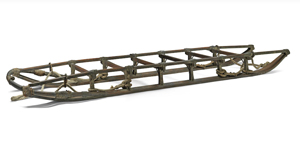
Shackleton 1907 – 09
Nimrod Expedition sledge
The method of construction varies according to the manufacturer but the design of the Nansens used by The British Antarctic Survey (BAS) goes back to before the Oxford University expeditions of the 1930s, the British Arctic Air Route Expedition of 1930-31, and the British Graham Land Expedition (BGLE) 1934 - 37.
Early Nansen sledges probably used Norwegian ski technology such as pine resin and waxes to produce a runner with good glide characteristics. Scott and Shackleton used hardwood for the runners which were then waxed. In the 1920s a resin bonded plastic called Tufnol became available. This is a composite material comprising a phenolic resin and cotton fabric. It is water resistant and has very low friction properties. Tufnol was certainly used on Commonwealth Trans Antarctic Expedition (TAE) 1955 – 58 Nansen sledges and given its availability in the 1920s it may have been available to BGLE. More recently I noticed that Ken Hedges’ BTAE Nansen (see The Fan Hitch PostScript Number 5, January 2020) was shod with Tufnol and BAS Nansens used Tufnol up to the 1970s. Unfortunately, once the outer layer of resin wears away, the friction becomes significantly greater as the cotton layers became exposed. More recently Ultra High Molecular Weight (UHMW) polyethylene has become the obvious and much better alternative.
For many years sledges for BAS and other customers were made by Roger Daynes of Snowsled with the assistance of David Ellis. After Roger retired all production was taken over by David at Ratcliffe Ellis Polar Equipment.
Construction of a modern BAS Nansen sledge starts with taking delivery of air-dried ash full width boards which are then cut to size lengthwise for runners and longitudinals. They are then left to stand for about four weeks to allow any tensions in the sawn wood to be released.
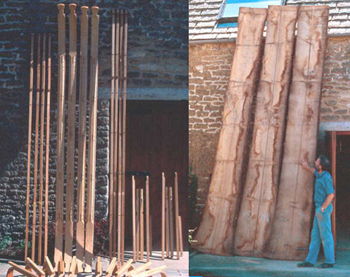
The raw materials and finished components for Roger Daynes’ first
Snowsledge Nansens in 1988
Construction of the sledge usually starts with the runners which are sized according to the requirements. The current BAS Nansen runners for use with skidoos and heavier loads are 100 mm wide by 37 mm and of suitable length for the standard 12 ft. sledges with five bridges. Sledges are also produced of reduced lengths, having either three or four bridges. These runners are thicker than those previously used for dog sledges but sledges can be produced according to the specific requirement. When I was at Halley Station with BAS in the 70s, we had a light weight man haul Nansen that was the perfect sledge to use with two dogs and Roger Daynes has produced light weight man haul Nansens for films recreating famous Polar journeys.
The sledge runners are shaped with a radius along either side of the flat section to make it easier to drill the holes to take the hide lashings and to lighten them. This leaves a thinner edge but a full thickness at the centre where mortices are cut to accept the tenons on the bridges. The runners remain at full thickness at the ends beyond the bridges where they are curved upwards. Holes are drilled to accept the Helvetia hide lashings securing the tenons on the bridges to the mortises on the runners.
The ends of the runners on a BAS Nansen are far too thick to be bent without special techniques. This consists of cutting two slots horizontally in the runner along its length on the table saw as far back as the beginning of the bend. Thin ash laminates are then machined and glued into these slots before clamping over a former and cold curing.
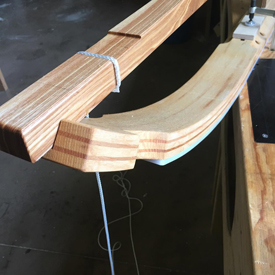
Ash laminates glued into slots cut into the runners.
This produces a runner with very strong laminated ends.
Traditionally the bridges were made of three pieces of ash, a cross piece and two uprights with mortise and tenon joints which were lashed together with Helvetia hide and reinforced underneath with a metal bracket wrapped with soldered wires. These bridges had the advantage of being easy to produce compared with the more modern laminated beech bridges adopted by BAS in the 1970s.
The change to laminated bridges came with the increasing use of skidoos which could haul heavier loads at higher speeds resulting in potentially rougher treatment to the sledge. The laminated bridges helped to produce a sledge able to cope with these new conditions.
Since 1988 the basic bridge production has been subcontracted to companies whose business is manufacturing wooden laminated furniture. Each bridge comprise 13 layers of 1.5 mm thick sheets of beech, glued and hot pressed over a former to produce a single long bridge which is sliced into sections to give the individual bridges. Tenons are cut on the ends of the bridges which fit into mortises cut into the upper surface of the runner. The bridge tenon rebates then bear on the runner surface to make a secure joint. A piece of ash is screwed into a rebate along the top of the bridge, to the full width of the sledge.
The runners are shaped at the ends and the bridges are attached with Helvetia hide lashings before the longitudinals are lashed on with polyester cord. This has replaced the polished flax cord which was traditionally used and required painting with tightening dope. The UHMW soles are screwed onto the runners through elongated holes to allow for the differential expansion/contraction of the plastic which can significant over the 12 ft length – the plastic is put on in two lengths, to minimise movement.
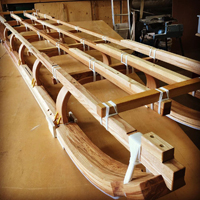 |
Construction
almost complete showing the radius
machined into the side of the runners, beech laminated bridges and runners shod with UHMW polyethylene. |
The cow catcher is formed from rattan which can be bent using a hot air blower around a former. When it has “set” it is lashed to the runner at the front with cord and to the runner behind the front bridge with Helvetia hide. For a dog sledge, handle bars are fixed to the rear using a system of U bolts, plates and bracing wires developed by Andrew Croft for Martin Lindsay’s 1933-34 Greenland expedition. There is a very good line drawing of a Nansen sledge in Greenland with metal attachments, in Croft’s 1991 book Talent for Adventure.
A dog sledge would also have a brake made from an ash board with metal teeth on the rear end. This would be lashed to the front bridges and extend to the rear of the sledge where the driver could operate it. When we first started using Nansen sledges with skidoos we often towed two sledges behind the skidoo, the front one had a cow catcher at both ends and the rear sledge was a traditional dog sledge with handlebars and brake which was operated by one of the two man team riding on the sledge. Nowadays teams operate with two skidoos, each with a double ended sledge. The sledges and skidoos can be hitched in any combination including putting one of the skidoos at the back to control descents. On steeper slopes rope or chain brakes can be used under the runners.
Keel plates can be fitted through the runners between the centre and fourth bridge back (of a 12 ft. sledge). They can be secured in a number of raised or lowered positions to reduce sideways sliding when traversing a slope.
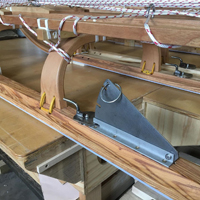 |
Keel plates and cow catcher fitted |
For use with dogs and/or with handlebars, the sledge is completed by the addition of towing ropes which are clove hitched around the centre bridge and wrapped round the two bridges in front. For the current standard double ended sledge the tow rope will run around the whole sledge. At the ends the tow rope is passed through a rope or tape dongler which is simply a sling wrapped around the cow catcher. Some Nansens used with skidoos where there is no risk of crevasses are fitted with an A frame. A continuous lash line is fitted around the sledge with hooks that were originally dog clips, these have been replaced by stainless snap-links and O-rings. The only treatment of the wood is to give it a coating of linseed oil which is reapplied at intervals throughout the life of the sledge.
Individual drivers whether of dogs or skidoos often make small modifications to suit their requirements. With dogs or if a passenger is riding on the sledge, a handlebar bag is often used and a compass is fixed to the handle bars. The dog picket and picket hammer are often hung from the handlebars. It is normal to protect the lashings with pieces of hide, canvas or even duct tape.
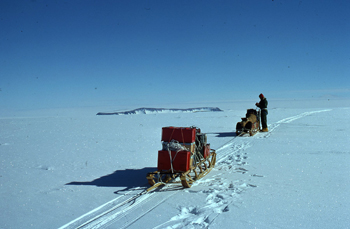
Shortly after the change from dogs to skidoos. A traditional
handlebar Nansen and a double cow catcher Nansen in the
Shackleton Mountains 1977-78.
Although this article has concentrated on the sledges currently produced for BAS and other polar programs, I hope it’s become clear that there is no definitive version of a “Nansen.” Although a dog sledge, Ken Hedges’ BTAE sledge is considerably heavier and wider than the current models which have evolved from the BAS dog sledges. Light weight man haul Nansens have been used for many years and Gisle Uren and Jens Otto Nørbech-Eidem have made a very neat, lighter weight Nansen dog sledge in Norway partly by reducing the thickness of the ends of the runners to be the same as the edges of the runner along the length of the sledge and by using traditional three piece bridges. Details can be seen at https://www.langsomt.no/sleden/

Lightweight Nansen dog sled under construction by Gisle Uren and
Jens Otto Nørbech-Eidem
In North America we can supply BAS pattern Nansen sledges at https://snowsledcanada.ca/ These sledges are manufactured by Ratcliffe Ellis in the UK. Perhaps of more interest to readers of The Fan Hitch PostScript would be lighter weight Nansens for dogs or man hauling which I’m considering producing here in Canada. I can be contacted at contact@polarsupplies.ca
Photograph Credits
Shackleton 1907-09 Nimrod Expedition sledge - unaccredited Internet download
Light weight Nansen dog sled - Gisle Uren
All other photographs:
Roger Daynes - (formerly Snowsled)
David Ellis - Ratcliffe Ellis Polar Equipment
John Wright - Polar Supplies.